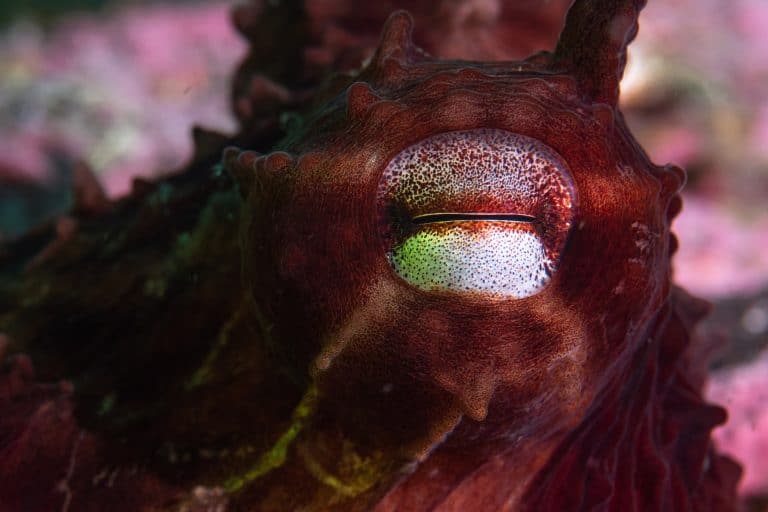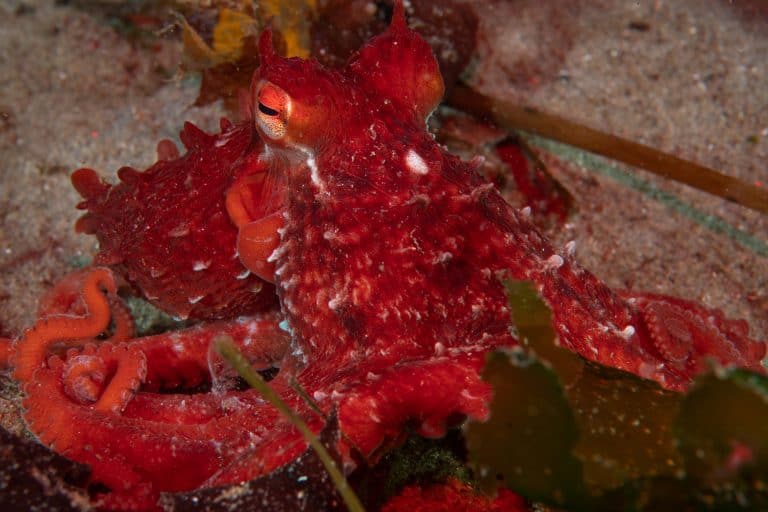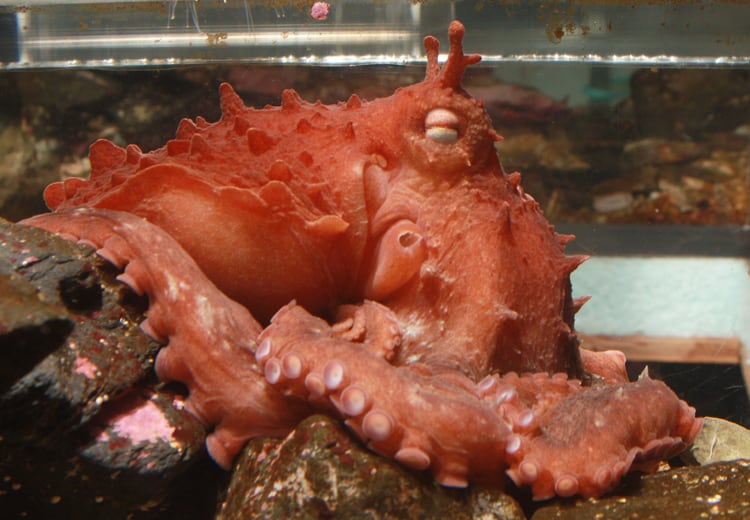Giant Pacific Octopus
Enteroctopus dofleini
The giant pacific octopus (or GPO to cephalopod enthusiasts) is well-named — it’s the biggest octopus in the world! It’s been known to reach 16 feet in length. That’s about as long as your average car!
Despite its huge size, this species is skilled in stealth. It can camouflage itself just as well as its smaller relatives, blending into rocky reefs and sandy seafloors with no problem.
Size
9-16 ft long (3-5 m)
Lifespan
3-5 years
Habitat
Shallow seas - rock, sand, mud
Diet
Crustaceans, bivalves, echinoderms, brachiopods, shark eggs, seabirds
Range
Coastal areas of the northern Pacific Ocean
Predators
Large fishes, sharks, seals, sea lions
superpower
Speedy Growth
This octopus grows really fast to get so big in a lifespan that lasts five years at most!
SCIENTIFIC NAME: Enteroctopus dofleini
Members of the genus are characterized by their large size and are often known as giant octopuses.
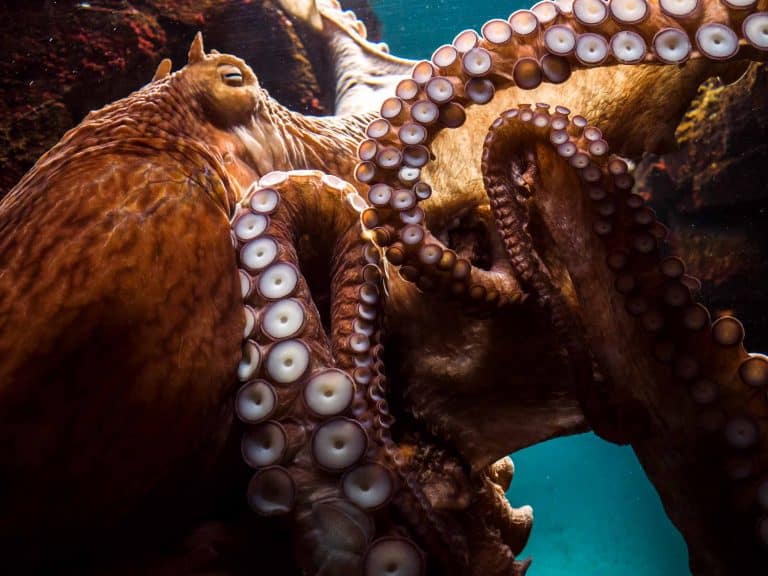
SIZE OF THE GIANT PACIFIC OCTOPUS
The giant Pacific octopus is the largest octopus species with a total length ranging 3-5 m (9-16 ft) and a body weight greater than 180 kg (396 lbs). Its mantle alone is at least 600 mm (2 ft).
GIANT PACIFIC OCTOPUS LIFESPAN
For such a large animal, it has a short life span: between 3-5 years.
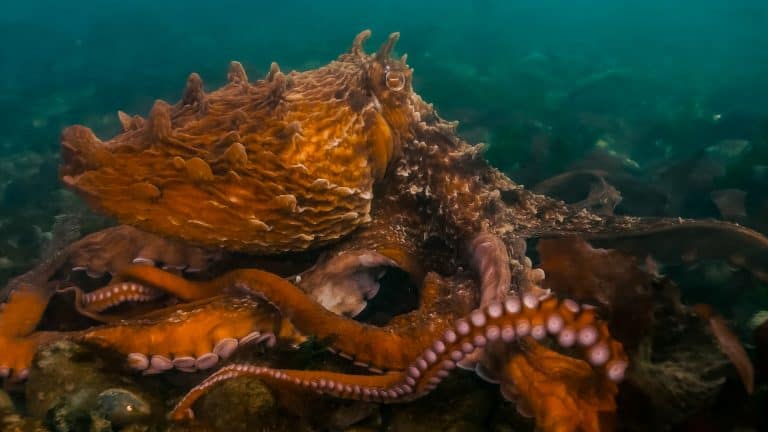
DISTRIBUTION
E. dofleini ranges throughout the temperate coastal waters of the Pacific along California, Oregon, Washington, British Columbia, Alaska, across the Aleutians to Russia, Japan, and Korean Peninsula.
HABITAT
The species is found in a variety of habitats. It typically inhabits rocky reefs or boulder areas with sand-shell substrate. At the northern end of its range, it is often found in intertidal waters and can also be found in very deep waters (down to 1500 m or almost 5,000 ft!) at the southern end of its range. The giant Pacific octopus has also been observed in sand and mud habitats. They use the same den for up to several months!
DIET
It is a benthic predator, hunting at night and feeding primarily on shrimps, clams, lobsters. Other prey includes echinoderms, brachiopods, assorted fishes, shark eggs, and even seabirds. The diet of this species has been studied from midden contents left at dens.
BODY PATTERNS AND BEHAVIORS
The giant pacific octopus has an orange to red-brown base color with fine irregular dark lines scattered over its dorsal surfaces. Their skin is winkled into parallel ridges or folds and they can have four large papillae in a diamond arrangement on dorsal mantle. Another key characteristic is the two large flattened papillae above the eye. This ability to texture its skin with folds and ridges allows it to blend into diverse habitats and camouflage from its primary predators such as large fishes, sharks, seals, sea lions, and mink.
DISCOVERY OF FRILLED GIANT PACIFIC OCTOPUS
Through genetic testing and observing body patterns, scientists have recently discovered there are two different species of giant Pacific octopus that inhabit Alaskan waters, specifically from Prince William Sound. Dubbed the frilled giant Pacific octopus, this new species is a sister taxon of the giant Pacific octopus. The frilled GPO shares many body pattern traits including relative head size, web extant, dark eye bars, and patterns of dorsal mantle white spots. However, this new species has a bumpy ridge across its body (fleshy “frills”) and two distinct white spots on its head. A full species description remains to be done!
MIGRATION OF GIANT PACIFIC OCTOPUS
In waters off Japan, the GPO has twice-yearly inshore-offshore migrations that coincide with seasonal inshore temperature changes. This species migrates inshore for optimal water temperatures in early summer and early winter and migrates offshore in late summer and late winter when water temperature is too hot or too cold inshore.
Although GPOs of Japan follow this seasonal migration pattern, that isn’t the case for all GPO populations. Scientists attached sonic trackers to look at movement patterns of 40 GPOs along the coast of south-central Alaska. Turns out movement patterns were related to several habitat characteristics including greater kelp coverage, shallower depth, and the presence of boulders on soft substrate.
This inshore/offshore migration has also been linked to reproduction. E. dofleini migrates offshore into deeper water in summer to mate. In autumn and winter, individuals migrate back inshore where eggs are spawned.
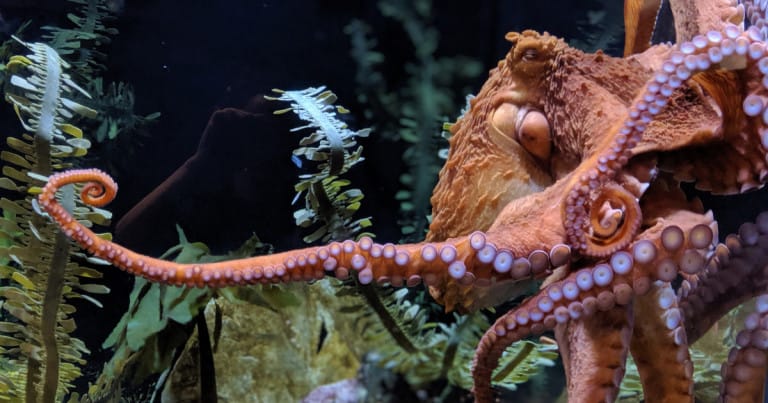
Mottet M (1975), Hartwick E (1983), Kubodera T (1992), Hartwick E and Barriga I (1997), Hochberg F (1998), Scheel D (2002), Cosgrove J (2003), Rigby P and Sakurai Y(2004, 2005), Anderson R and Mather J (2007), Anderson R et al. (2007, 2010), Scheel D et al. (2007), Furuya H (2008), Landman N et al. (2008), Villanueva R and Norman M (2008), Cosgrove J and McDaniel N (2009), Jorgensen E (2009), Zalygalin V (2009), Barry P et al. (2010, 2011), Conners E (2010), Hadjisolomou S and Grasso F (2010). IN Jereb P, Roper CFE, Norman MD, Finn JK (eds) (2014) Cephalopods of the world. An annotated and illustrated catalogue of cephalopod species known to date. Volume 3. Octopods and Vampire Squids. FAO Species Catalogue for Fishery Purposes. No. 4, Vol. 3. Rome, FAO. pp.124-125
Scheel D and Bisson L (2012) Movement patterns of giant Pacific octopuses, Enteroctopus dofleini (Wülker, 1910). Journal of Experimental Marine Biology and Ecology. 416–417: 21–31 doi: 10.1016/j.jembe.2012.02.004
Hollenbeck N, Scheel D, Gravley MC, Sage GK, Toussaint R, Talbot SL (2017) Use of Swabs for Sampling Epithelial Cells for Molecular Genetics Analyses in Enteroctopus. American Malacological Bulletin 35:145–157
Hollenbeck N and Scheel D (2017) Body Patterns of the Frilled Giant Pacific Octopus, a New Species of Octopus from Prince William Sound, AK. American Malacological Bulletin 35:134-144
Toussaint RK, Scheel D, Sage GK et al. (2012) Nuclear and mitochondrial markers reveal evidence for genetically segregated cryptic speciation in giant Pacific octopuses from Prince William Sound, Alaska. Conserv Genet 13, 1483–1497 https://doi.org/10.1007/s10592-012-0392-4
Our mission is simple: We work to inspire wonder of the ocean by educating the world about octopuses.
We work with scientists, educators, and artists to make a global impact.
OctoNation® is a 501(c)(3) Nonprofit Organization
